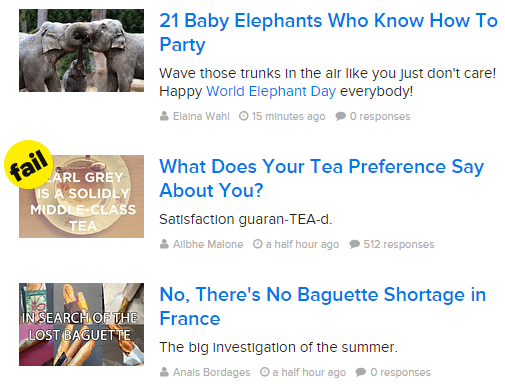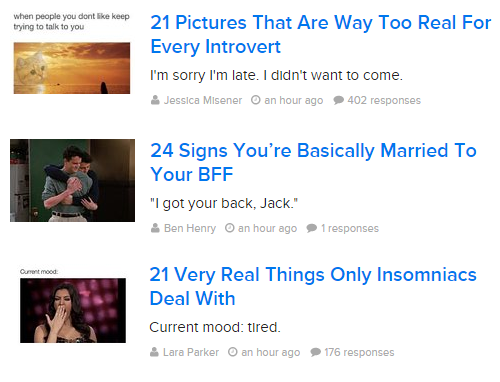Launched in 2006, BuzzFeed has become one of the most popular “internet news” and media sites on online, with around 175 million monthly users.
Featuring entertaining articles, listicles (yes, it’s a word!), human stories, and addictive quizzes, its sheer content output puts most other websites to shame.
[Tweet “9 Things Internet Marketers Can Learn From BuzzFeed”]BuzzFeed may not be one of the most highbrow online publications, but it knows how to get readers to connect with its content.
Even traditional media outlets have started to copy its style. But there’s more to BuzzFeed than shareable lists.
The following are ten content marketing lessons any marketer can learn from BuzzFeed’s success.
Related: Vary your content types to supercharge success
Make Your Content Shareable
Today’s social media generation loves to share content. In fact, around 75 percent of BuzzFeed’s traffic referrals are from social media.
With this in mind, make sure you promote your content on the right social media channels, and include social sharing buttons throughout your content.
But more importantly, create content that your audience will want to share.
Write Clickable, Honest Headlines
Many BuzzFeed articles are successful because the headlines are so well-written and intriguing.
Whilst some of the titles are a little “clickbait”; they follow through with content that always remains true to the headline. Don’t mislead your visitors, as this will undoubtedly caused an undesired high bounce rate.

Not every business is going to have the luxury of working with such a range of fun, interesting, and…. well, silly content – but never underestimate the power of a good headline.
List-Form Content Works
It’ll come as no surprise to most content marketers, but listicles are still one of the most scannable and shareable forms of content.
They’re also easy to consume on mobile devices and are ideal for people looking for a couple of minutes to kill.
 The frequency of how often a busy site like Buzzfeed uses listform content is evidence enough of how effective it can be
The frequency of how often a busy site like Buzzfeed uses listform content is evidence enough of how effective it can be
Lists aren’t just for twenty-somethings though; this type of content can even be adapted for B2B companies.
Related: Why your blog needs a content calendar
Use Emotional Content
People are more likely to share something that triggers an emotion.
Think about nostalgia, humour, pity, envy, empathy, embarrassment, hope, and surprise – they’re all themes that crop up again and again in BuzzFeed articles.
What content could you create to make your audience feel these emotions?
Know Your Audience
You can’t connect with your audience unless you know something about them.
As BuzzFeed’s core audience is mostly twenty-something, professional, and female, a lot of their prime content is aimed at this audience sector.
The content is popular because the audience can relate to what they read. Identify your target audience and make sure your content speaks directly to them.
Use Interactive Content
The more interactive your content is, the more exciting, memorable, and shareable it will become. One way BuzzFeed achieves this is through its use of quizzes.

In fact, some of its most shared content pieces are quizzes. Use a tool like Qzzr to create your own quizzes that you can then embed on your website.
Create Mobile-Friendly Content
Today, around 60 percent of people who read BuzzFeed are doing so on a mobile device. View BuzzFeed on a mobile, and you’ll see how easy it easy to navigate their site and read content.
It loads quickly, there aren’t any distractions, and the headlines and images are the most important feature.
Its simplicity is what makes users read the content and click on links to read more.
Related: Why mobile-friendly responsive design matters
Don’t Ignore Long-Form Content
Despite BuzzFeed being renowned for its “list” articles, it is still dedicated to serious journalism and longer content.
Its Big Stories section features more personal, human, and global news stories. Some of these stories have around a million views.
Think about what content topics you could tackle in long-form content. It’s good for credibility and also for SEO.
Monitor Your Analytics
BuzzFeed staff constantly use analytics to see which content pieces are the most interesting and shareable, and then adjust future content strategies to replicate their successes.
The most successful content pieces – with more shares or views – get featured more prominently on its home page.
Conclusion
Most businesses can learn something about content marketing from BuzzFeed’s success.
The important thing to remember is to use the strategies that apply best to your unique business.
Obviously, not everything that BuzzFeed does will be appropriate for your business, but you can use these guidelines to improve content engagement and ultimately drive more traffic to your website.
Your Say!
Why do you think BuzzFeed is so successful? Please let us know your thoughts in the comments section below.

3 thoughts on “Content Marketing : 9 Things You Can Learn From BuzzFeed”
Comments are closed.